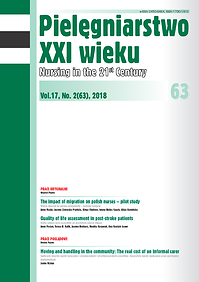The impact of migration on polish nurses – pilot study
DOI:
https://doi.org/10.2478/pielxxiw-2018-0009Keywords:
cultural shock, acculturation, strategy, nurses, migrationAbstract
THE IMPACT OF MIGRATION ON POLISH NURSES – PILOT STUDY
Introduction. Migration of professional nurses is a global phenomenon. Polish nurses usually migrate to the relatively richer countries, especially in Europe, thanks to the opening of the borders of the European Union (2004) and legal regulations in the field of education of nurses (Directive 2005/36/EC).
Aim. The analysis of symptoms and determinants of acculturative stress and acculturative strategies among Polish migrant nurses working in the UK.
Material and methods. The study used a proprietary questionnaire and standardized tool the East Asian Acculturation Measure - Scale of Acculturative Strategy. The research was carried out through Internet among 62 people. Statistical analysis was performed using Mann-Whitney test, Kruskal-Wallis test, Dunn test, coefficient Spearman.
Results. The main reason for the migration of respondents to the UK was the desire to improve financial situation and professional development. Responders found job as a nurse, including a charge nurse and managers in hospitals and nursing homes. Acculturative stress manifested most often in social functioning, then in the emotional, cognitive and physical aspects. It was characterized by a sense of lack of interest from British people, sadness, feelings of loneliness, lower self-confidence and shyness. It was determined significantly by the age of the respondents, the length of stay in the UK, knowledge of English and maintaining social contacts with the British. The most commonly used acculturation strategy was integration, conditioned by the length of stay in the UK and symptoms of acculturative stress.
Conclusions. Working in a foreign country is associated with acculturative stress, implementation of acculturation adaptive and non-adaptive strategies.
References
1. International Organisation of Migration. World migration 2003 – managing migration. Challenges and responses for people on the move. Vol 2. Geneva: IOM; 2003.
2. Haberman M, Stagge M. Nurse migration: a challenge for the profession and health-care systems. J Public Health. 2010; 18(1): 43-51. http://link.springer.com/article/10.1007/s10389-009-0279-0, p. 8; dostęp 20.12.2016.
3. Kingma M. Nurses on the move. London: Cornell University Press; 2006. http://link.springer.com/article/10.1007/s10389-009-0279-0; dostęp 20.12.2016.
4. Kautsch M. Migracje personelu medycznego i ich skutki dla funkcjonowania systemu ochrony zdrowia w Polsce. Zdrowie Publiczne i Zarządzanie. 2013; 11(2): 169-179.
5. Monitorowanie migracji polskich lekarzy, pielęgniarek i położnych po przystąpieniu Polski do Unii Europejskiej. Raport z realizacji programu w 2006 r. http://www.mz.gov.pl/wwwmz/index?mr=&ms=&ml=pl&mi=565&mx=0&ma=787; dostęp: 20.12.2016.
6. Binkowska-Bury M, Nagórska M, Januszewicz P, Ryżko J. Migracje pielęgniarek i położnych – problemy i wyzwania. Przegląd Medyczny Uniwersytetu Rzeszowskiego i Narodowego Instytutu Leków w Warszawie. 2010; 4: 497-504.
7. Wyjeżdża ich coraz mniej, ale czy pielęgniarki wrócą z saksów?, z 14.02.2018 http://www.medonet.pl; dostęp: 14.04.2018.
8. NHS alarmuje: w szpitalach brakuje rąk do pracy, z 12.11.2017. https://www.england.pl/aktualności/wielka-brytania; dostęp: 14.04.2018.
9. Matsumoto D, Juang L. Psychologia międzykulturowa. Gdańsk: GWP; 2007.
10. Kownacka E. W kraju nowego azylu – szok akulturacyjny i strategie akulturacji. [w:] Lipińska M, red. Warsztaty kompetencji międzyakulturacyjnych – podręcznik dla trenerów. Warszawa: Inicjatywa Wspólnotowa EQUAL; 2008, 47-56.
11. Chutnik W. Szok akulturacyjny, konsekwencje, przeciwdziałanie. Kraków: Universitas; 2007.
12. Guru R, Siddiqui MA, Ahmed Z, Khan AA. Effects of cultural shock on foreign health care professionals: An analysis of key factors. J Environmental Occupational Science 2012; 1(1): 53-62.
13. Osland J, Bird A. Beyond Sophisticated Stereotyping: Cultural Sense making in Context. Academy of Management Executive. 2000; 14(1):65-77.
14. Boski P. Kulturowe normy zachowań zdrowotnych. Podręcznik psychologii międzykulturowej. Warszawa: Wydawnictwo Naukowe PWN, Academica Wydawnictwo SWPS; 2009.
15. Zalewska-Puchała J, Majda A. red. Różnorodność kulturowa w opiece pielęgniarskiej. Wybrane zagadnienia. Kraków: Wydawnictwo MOIPiP; 2014.
16. Babbie E. Badania społeczne w praktyce. Warszawa: Wydawnictwo Naukowe PWN; 2004.
17. Barry TD. Development of a New Scale for Measuring Acculturation: The East Asian Acculturation Measure (EAAM). J Immigrant Health. 2001;3(4):193–197.
18. Deklaracja Helsińska. http://www.nil.org.pl/data/assets/pdf_file/0008/93248/Deklaracja-Helsinska-przyjeta-na-64-ZO-WMA-pazdziernik-2013_pelny-tekst.pdf (15.08.2016).
19. Seo K, Kim M, Lee G, et al. The Impact of Acculturation and Social Support on Mental Health among Korean-American Registered Nurses. Korean J Adult Nursing. 2013; 25(2):157-169.
20. Ching GS, Chao P-Ch, Lien W-Ch. Acculturative hassles and strategies: Relationship between study abroad related depression, anxiety, and stress. International J Research Studies Psychol. 2014; 3(5): 3-25.
21. Rizki O. The Impact of Religiosity on Acculturation Strategies and Psychological Distress. A thesis submitted in partial fulfilment of the requirements for the degree of Master of Science (Psychology) in the University of Michigan-Dearborn, 2016.
22. Grzymała-Moszczyńska H, Kownacka E. Szok akulturacyjny – zło konieczne?. Alma Mater 2005,71. http://www3.uj.edu.pl/alma/alma/71/01/18.html. dostęp: 20.12.2016.
23. Paszkowska-Rogacz A, Olczak E, Kownacka E, Cieślikowska D. Doradztwo zawodowe a wyzwania międzykulturowe. Warszawa: KOWEZiU; 2006.
24. Szkup M, Polakiewicz P, Schneider-Matyka D, Jurczak A. i wsp. Analiza stresu związanego z akulturacją oraz strategii radzenia sobie ze stresem wśród studentów English Program Pomorskiego Uniwersytetu Medycznego w Szczecinie. Probl. Piel. 2014; 22(1): 74-81.
25. Szymaniak A. Uwarunkowania i prognozy migracji zarobkowych Polaków. W: Wojciechowski S., Fiedler R.: Europa – Polska – Migracja. Poznań: Wydawnictwo Uniwersytetu im. Adama Mickiewicza; 2003.
Published
Issue
Section
License
Copyright (c) 2018 Authors

This work is licensed under a Creative Commons Attribution-NonCommercial-NoDerivatives 3.0 Unported License.




